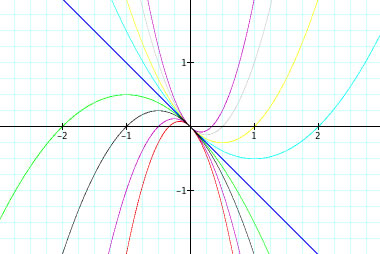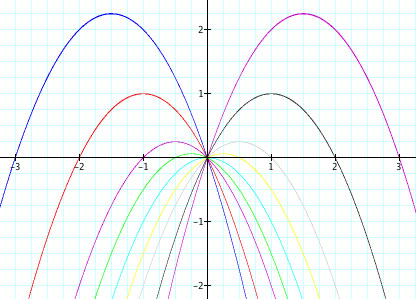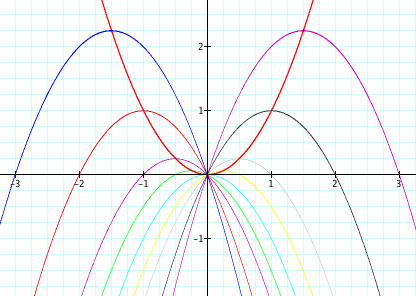

Ronald Aguilar
Considering graphs in the xc planes using
Lets start by using different coefficients for a

![]() in black
in black
![]() in purple, bottom graph
in purple, bottom graph
![]() in red
in red
![]() in blue
in blue
![]() in green
in green
![]() in turquise
in turquise
![]() in yellow
in yellow
![]() in gray
in gray
![]() in purple, top graph
in purple, top graph
Now, lets use different coefficients for b

![]() in purple, bottom graph
in purple, bottom graph
![]() in red
in red
![]() in blue
in blue
![]() in green
in green
![]() in turquise
in turquise
![]() in yellow
in yellow
![]() in gray
in gray
![]() in black
in black
![]() in purple, top graph
in purple, top graph
As you can see, no matter what the vertices are the parabolas all go through the origin (0,0) and intersect one another. To get a general idea of why this is, I looked at each equation and of course noticed that every equation has ![]() . If we were to solve for y, we simply substract y from both sides of the equation. I concluded thats why all the parabolas showed negative characteristics for parabolas. All the parabolas have a maximum point. Lets graph the equation
. If we were to solve for y, we simply substract y from both sides of the equation. I concluded thats why all the parabolas showed negative characteristics for parabolas. All the parabolas have a maximum point. Lets graph the equation ![]() to see what happens to the intersections of the graph.
to see what happens to the intersections of the graph.

The parabola ![]() goes through every vertices. Lets use the original quadratic equation
goes through every vertices. Lets use the original quadratic equation ![]() . In order to get the vertices of this equation and any other equation we must complete the square. In all this is expressed into vertex form:
. In order to get the vertices of this equation and any other equation we must complete the square. In all this is expressed into vertex form:
![]()

If we go back through and complete the square for each equation we get the vertices to be 
Where the axis of symmetry is x = . If we were to "fold" the parabola in half this where we "fold" the parabola.
. If we were to "fold" the parabola in half this where we "fold" the parabola.
In summary, notice that y-coordinate is the square of the x-coordinate. That is why the vertices touch the parabola ![]() .
.
![]() , (h,k) is the vertex.
, (h,k) is the vertex.